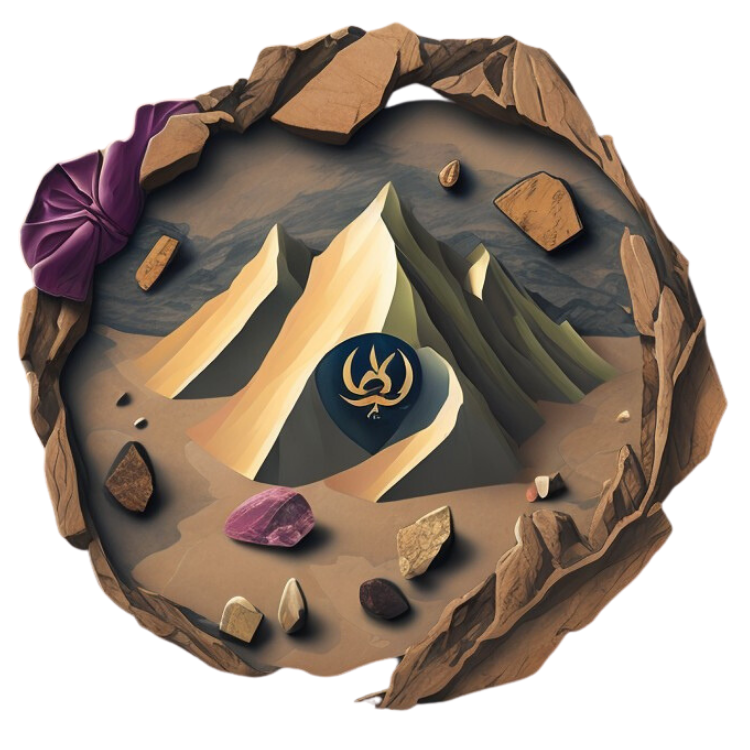Urban Rockhounding: Crystal Hunting in the Concrete Jungles of the US
Click here to see our crystal hunting maps
Urban rockhounding, or the practice of hunting for crystals and minerals within city environments, is an exciting and accessible hobby that has seen a significant rise in popularity in recent years. Unlike traditional rockhounding, which often requires trips to remote and rural areas, urban rockhounding offers the thrill of discovery right in the heart of bustling cities. This innovative approach allows enthusiasts to explore the geological diversity found within urban environments, often in unexpected places like construction sites, parks, riverbeds, and old quarries.
This article will delve into the fascinating world of urban rockhounding, providing a comprehensive guide to get you started on your crystal hunting adventures in the concrete jungles of the US.
Brief Overview of the Rise of Urban Rockhounding in the US
The concrete jungles of the United States hold more than just skyscrapers and busy streets. Beneath the urban veneer lies a hidden world of geological treasures waiting to be discovered.
While urban areas might not seem like the typical location for crystal hunting or rock collecting, the practice of urban rockhounding has gained momentum over the years due to several factors including:
- The increasing popularity of geology and rock collecting as a hobby, which has led to more people looking for crystals in urban areas.
- The desire to connect with nature and the earth in an increasingly urbanized world.
- The accessibility of urban areas for rockhounding due to their proximity to major cities and transportation networks.
- The increasing popularity of crystals and gemstones as a form of alternative medicine and holistic healing.
- The rise of social media platforms like Instagram, which have made it easier for people to share their finds with others.
- The fact that many urban areas are built on top of former mining sites or quarries, provides an abundance of rocks and minerals just waiting to be discovered.
- The growing number of people who are interested in learning about geology and earth science.
- The fact that many cities have their own unique geology that can be explored by rockhounds.
- Another factor is that many cities have experienced rapid growth over the past few decades, resulting in new construction projects that often disturb previously undisturbed areas.
- The idea of finding valuable and beautiful minerals in unexpected places like construction sites, parks, and riverbeds within urban areas has captured the imagination of many enthusiasts.
Urban Rockhounding Vs Traditional Rockhounding
While traditional rockhounding often involves hiking to remote locations, exploring quarries, and camping in the wilderness, urban rockhounding is more accessible and can be done as a part of daily city life. The urban environment offers unique challenges and opportunities, such as dealing with construction debris and navigating public spaces, but it also provides easier access and more frequent opportunities for discovery.
| Feature | Urban Rockhounding | Traditional Rockhounding |
|---|---|---|
| Location | Cities and urban areas | Wilderness and remote areas |
| Accessibility | Easily accessible | May require travel and permits |
| Equipment | Portable and compact | May require heavier gear |
| Finds | Construction debris, riverbeds | Natural formations, exposed rock |
| Safety Considerations | Urban hazards, permissions | Wilderness risks, wildlife |
| Community | Growing online presence | Established clubs and groups |
Benefits of Urban Rockhounding
Urban rockhounding offers numerous benefits, from the accessibility and convenience of urban locations to the opportunities to learn more about geology and history making it an appealing hobby for a wide range of people. Some of the common benefits of urban rockhounding include:
- Accessibility: Urban rockhounding can be done close to home, eliminating the need for long trips and extensive planning.
- Educational Value: It provides an opportunity to learn about urban geology and the natural history of cities.
- Community Engagement: It fosters a sense of community among rockhounds, often leading to the formation of clubs and societies.
- Health and Wellness: The physical activity involved in rockhounding promotes health and well-being.
- Sustainable Hobby: It encourages recycling and repurposing materials, especially when hunting in construction sites and old quarries.
- Environmental Awareness: It promotes a deeper understanding of the natural world and encourages responsible collecting practices.
RELATED TOPIC: Crystal Hunting Near You: Top Spots for Unearthing Gems in the US
Best Urban Rockhounding Locations in the US
While urban rockhounding opportunities exist in many cities throughout the US, some cities are particularly known for their abundance of rockhounding locations. Here are some of the best cities for urban rockhounding in the US:
1. New York City, New York

The Big Apple might not be the first place that comes to mind for crystal hunting, but New York City offers a surprising array of locations for rockhounding. Some of the best places to look for crystals in the city include:
- Central Park: This iconic park is not just a green oasis but also a geological treasure trove. The exposed bedrock in the park is Manhattan Schist, a metamorphic rock dating back millions of years. While you won't find gemstones, you can discover interesting minerals like quartz, mica, and feldspar.
- Inwood Hill Park: Located at the northern tip of Manhattan, Inwood Hill Park features exposed outcrops of Inwood Marble, a beautiful white marble with intricate patterns.
Common Discoveries: Quartz, garnets, and various feldspar minerals.
2. Seattle, Washington
The Emerald City is a great place for urban rockhounding, with many green spaces and bodies of water nearby. Some of the best places to search for minerals in Seattle include:
- Discovery Park: This large park has a variety of habitats, including a rocky beach where you can find agate, jasper, and petrified wood. Keep an eye out for interesting patterns and colors in the agates.
- Seward Park: Located on the shores of Lake Washington, this park offers opportunities to find agates, jasper, and other colorful rocks along the beach.
- Lake Washington Shoreline: Explore other beaches along Lake Washington for additional rockhounding opportunities.
Common Discoveries: Quartz, agate, and petrified wood.
3. Chicago, Illinois
The Windy City might surprise visitors with its ample urban rockhounding locations. Some of the best places to search for rocks and minerals in Chicago include:
- Montrose Beach: Lake Michigan's shoreline is a surprising spot for rockhounding. At Montrose Beach, you can find colorful pebbles and stones polished by the waves, including agates, jasper, and even fossils.
- Lincoln Park: The park's landscaping features rocks from various parts of the country, offering a chance to find interesting specimens.
- Calumet Region: This industrial area south of Chicago is known for its slag, a byproduct of steel production. Slag can contain interesting minerals like olivine and pyroxene.
Common Discoveries: Fluorite, pyrite, and calcite.
4. Denver, Colorado
The Rocky Mountains surrounding Colorado's capital offer great opportunities for urban rockhounding. Some of the best places to search for rocks and minerals in Denver include:
- Red Rocks Amphitheatre: This famous music venue is built into a natural amphitheater of red sandstone. While collecting is prohibited within the amphitheater, the surrounding area offers opportunities to find red jasper and other interesting rocks.
- South Platte River: The riverbed is a prime location for finding a variety of rocks and minerals, including quartz, feldspar, and agate.
- Cherry Creek Trail: This popular trail runs along Cherry Creek and offers access to exposed rocks and gravel bars.
Common Discoveries: Quartz, amethyst, and amazonite.
5. Los Angeles, California
Los Angeles is a great place to find rocks and minerals, especially if you're willing to travel a bit. The city is surrounded by mountains that provide plenty of opportunities for rockhounding. Some of the best places to look for rocks in Los Angeles include:
- Griffith Park: This sprawling park is home to various geological formations, including the Hollywood Hills and the Cahuenga Pass. Keep an eye out for chalcedony, jasper, and agate in the park's rocky areas.
- Elysian Park: Located near Dodger Stadium, this park offers exposed sedimentary rocks and occasional fossils.
- San Gabriel Mountains Foothills: While not technically in the city center, the foothills of the San Gabriel Mountains are easily accessible from LA and offer opportunities to find quartz, feldspar, and mica.
Common Discoveries: Quartz, jasper, and agate.
6. San Francisco
The city by the bay is a treasure trove for urban rockhounding enthusiasts. Some of the best places to search for rocks and minerals in San Francisco include:
- Lands End: This coastal area offers stunning views and unique geology. Look for chert, jasper, and serpentine along the cliffs and shoreline. Serpentine is California's state rock and can be found in a variety of colors and textures.
- Crissy Field: This former airfield is now a popular recreational area with a rocky shoreline. Search for agate, jasper, and chert among the pebbles and cobbles.
- Marin Headlands: Just across the Golden Gate Bridge, the Marin Headlands offer a variety of geological formations and potentially finds like serpentine, chert, and even radiolarian chert, a type of chert that contains microscopic fossils.
Common Discoveries: Agate, jasper, chert, serpentine, radiolarian chert (a type of chert that contains microscopic fossils)
7. Boston, Massachusetts
Boston is a great place to find rocks and minerals. The city has a rich geological history, with many different types of rocks and minerals found in the area. Some of the best places to look for rocks in Boston include:
- Charles River Esplanade: This popular walking and biking path runs along the Charles River and offers access to exposed rocks and gravel bars. Look for quartz, granite, and slate along the riverbank.
- Arnold Arboretum: This botanical garden features a variety of rock formations and landscaping that may contain interesting specimens like granite, basalt, and schist.
- Middlesex Fells Reservation: This large forested reservation has various rock formations, including granite outcrops and glacial erratics. Explore the trails and streams for quartz, feldspar, and mica.
Common Discoveries: The most common rocks found in Massachusetts are granite, basalt, and schist.
8. Miami, Florida

Miami is a popular destination for rockhounds because it has a variety of interesting geology. The city is built on limestone, which is made up of the remains of marine organisms that lived in shallow seas millions of years ago. Some of the best places to rockhound in Miami are:
- Oleta River State Park: This urban park has a variety of natural habitats, including mangrove forests and a rocky shoreline. Look for coquina (a sedimentary rock made of shells), limestone, and fossilized shells on the beach.
- Bill Baggs Cape Florida State Park: Located on the southern tip of Key Biscayne, this park offers a beautiful beach and potential finds like coquina, limestone, and fossilized coral.
- Atlantic Coast Beaches: Many beaches along the Atlantic coast offer opportunities to find interesting rocks, shells, and even shark teeth.
Common Discoveries: The most common finds in Miami are shells, coquina, limestone, and fossilized coral. You may also find shark teeth on the beach.
9. Philadelphia
Philadelphia is a great place to find fossils. The city is located on the Delaware River, which has been a major shipping route for hundreds of years. This means that there are many places where you can find interesting rocks and fossils. Some popular locations include:
- Fairmount Park: Explore the Wissahickon Creek Gorge, a scenic area with exposed bedrock and the potential to find Wissahickon schist, a metamorphic rock containing quartz, mica, and sometimes garnet. Keep an eye out for interesting structures like folds and faults in the rock formations.
- Wissahickon Valley Park: This park is known for its diverse geology, with the Wissahickon Creek cutting through various rock types. Look for quartz crystals, mica flakes, and even small garnets in the streambed. The park is also home to the historic Valley Green Inn, constructed from local schist.
- Delaware River Waterfront: The Delaware River's shoreline can be a good place to find tumbled rocks and pebbles, including jasper, chert, and even fossils washed in from upstream.
10. Atlanta
Atlanta is a great place to find rocks, especially if you're willing to drive a little bit. The city is surrounded by mountains and hills that are full of interesting geology.
- Stone Mountain: This massive granite dome is a popular tourist attraction and a great place for rockhounding. While collecting is restricted on the mountain itself, the surrounding area offers opportunities to find quartz, feldspar, and mica.
- Chattahoochee River National Recreation Area: This sprawling park along the Chattahoochee River offers access to various geological formations and the potential to find quartz, feldspar, and even fossils.
Common Discoveries: The most common discoveries in Georgia are quartz, feldspar, and mica. You can also find garnets and other minerals, but these are less common.
11. Austin, Texas
Austin is a great place to find rocks and minerals. The city is surrounded by the Texas Hill Country, which offers plenty of opportunities for rockhounding. There are also many parks in and around Austin that allow you to collect minerals legally. Some of these locations include:
- Barton Creek Greenbelt: This natural area offers hiking trails and access to Barton Creek, where you can find limestone, fossils, and quartz.
- Zilker Park: This popular park is home to Barton Springs Pool, a natural spring-fed pool with limestone formations that may contain fossils.
Common Discoveries: The most common rocks and minerals found in Austin include limestone, sandstone, quartz, and calcite. You can also find fossils of marine life such as clams and snails.
RELATED TOPIC: Best Rockhounding Sites for Families in the US: A Guide to Finding Gems and Minerals
Notable Rockhounding Sites Within Cities
Each city offers unique rockhounding sites. These include:
- Construction Sites: Often rich in newly exposed minerals.
- Parks: Natural outcrops and landscaped areas can yield surprising finds.
- Riverbanks: Erosion and water flow can reveal hidden crystals.
- Old Quarries: Abandoned quarries within city limits are prime spots for rockhounding.
- Private Property: Some landowners allow rockhounding on their property, so long as you ask permission first.
- Road Cuts: Road cuts are often made through rock, exposing new minerals. You can find these in any city, but they're especially common near highways and interstates.
- State Parks: Many state parks offer rockhounding opportunities. Some even have designated areas where you can collect minerals and fossils.
- Golf Courses: Many golf courses have been built on old quarries, which can yield interesting finds.
Types of Crystals and Minerals Found in Urban Areas
Urban areas can yield a variety of crystals and minerals, including:
- Quartz: Commonly found in various forms such as clear quartz, smoky quartz, and amethyst.
- Fluorite: Often found in construction sites and old industrial areas.
- Garnet: Frequently discovered in parklands and natural outcrops within cities.
- Pyrite: Also known as "fool's gold," commonly found in construction debris and riverbeds.
- Calcite: A common component of concrete and limestone, calcite crystals may be found in construction debris.
- Agate and Jasper: Found in riverbanks and landscaped areas.
Tools and Equipment for Urban Rockhounding
When rockhounding in urban environments, portability and practicality are key. Here are some essential tools:
- Rock Hammer: A must-have for breaking rocks and extracting minerals.
- Chisels: Useful for detailed work and prying apart rocks.
- Safety Gear: Gloves, goggles, and a hard hat to protect against debris and accidents.
- Portable Sieve: For sifting through soil and sediment, especially in riverbeds.
- Field Guide: A guidebook for identifying rocks and minerals on the go.
- Collection Bags: Sturdy bags or containers for carrying finds.
- Magnifying Glass: To examine specimens closely.
- GPS or Maps: To navigate urban landscapes and mark locations.
- First Aid Kit: For minor injuries.
- Permission: Always obtain permission before collecting on private property.
Techniques for Urban Rockhounding
Finding crystals and minerals in urban environments requires some creative thinking and techniques. Some tips for locating and extracting crystals in urban areas include:
- Research and Planning: Study local geology and historical maps to identify potential sites.
- Network with Locals: Join local rockhounding clubs and forums to share tips and find new locations.
- Construction Sites: Seek permission to explore construction sites where earthmoving exposes new rocks.
- Parks and Natural Outcrops: Explore less frequented areas of parks where bedrock may be exposed.
- Riverbeds and Shorelines: Look for areas where water flow has eroded banks, revealing mineral deposits.
- Old Quarries: Check for abandoned quarries that may be accessible for collecting.
- Demolition Sites: With permission, explore demolition debris for hidden treasures.
Methods for Safely and Efficiently Searching Through Construction Debris, Riverbeds, and Other Urban Sites
- Construction Debris: Carefully sift through debris with a sieve, watching for sharp objects and unstable piles.
- Riverbeds: Use a portable sieve to filter sediment and look for crystals along the waterline.
- Safety First: Always wear safety gear, be aware of your surroundings, and avoid unstable structures.
RELATED TOPIC: The Ultimate Rock Hammers Guide for Rockhounding Enthusiasts
Safety and Legal Considerations
Urban rockhounding comes with specific safety and legal considerations:
- Obtain Permissions: Always seek permission from property owners or authorities before rockhounding.
- Follow Local Laws: Be aware of local regulations regarding rock and mineral collection.
- Safety Gear: Wear appropriate protective gear to avoid injury.
- Avoid Hazardous Areas: Steer clear of restricted zones and unstable structures.
Urban Rockhounding Etiquette
Proper etiquette ensures a positive experience for all:
- Respect Property: Always seek permission and respect private and public property.
- Leave No Trace: Clean up after yourself and avoid damaging the environment.
- Share Knowledge: Help fellow rockhounders by sharing tips and locations.
- Be Considerate: Avoid disturbing others and maintain a low profile in residential areas.
Challenges of Urban Rockhounding
Urban rockhounding presents unique challenges:
- Limited Access: Some areas may be off-limits due to private ownership or regulations. Obtaining permission to collect on private property can be challenging.
- Environmental Impact: Responsible rockhounding is crucial to avoid negative environmental effects.
- Safety Hazards: Urban environments present unique safety hazards, such as traffic, construction equipment, unstable structures, sharp debris, and uneven terrain.
- Misidentification: It can be difficult to identify rocks and minerals without proper training and resources.
- Limited Space: Urban areas often have limited access to exposed rock and geological formations.
Urban Rockhounding Community and Resources
Joining local clubs and societies can enhance your rockhounding experience, especially in urban areas. Some very helpful resources are:
- Clubs: Many cities have rockhounding clubs that organize field trips and meetings.
- Online Forums: Connect with other enthusiasts through forums and social media groups.
- Workshops and Events: Participate in workshops and events to learn new techniques and meet fellow rockhounds.
- Field Guides and Books: Invest in good field guides to help identify rocks and minerals.
- Educational Websites: Many websites like rockhounding.org offer valuable information on urban geology and rockhounding.
- Local Libraries: Libraries often have resources on the geology and history of your area.
Success Stories and Notable Finds in Urban Rockhounding

Urban rockhounding has led to some impressive discoveries:
-
The Herkimer "Diamond" Rush in Upstate New York:
Discovery: Construction workers in Herkimer County, New York, unexpectedly unearthed stunning double-terminated quartz crystals while excavating for a new housing development.
Significance: These unique crystals, nicknamed "Herkimer Diamonds," sparked a rockhounding frenzy, attracting enthusiasts from all over to search for these sparkling treasures in the clay-rich soil of the region.
Legacy: The Herkimer Diamond Mines are now a popular tourist destination and a testament to the unexpected discoveries that can occur in urban settings.
-
Fluorite Finds in Philadelphia's Urban Jungle:
Unexpected Beauty: During demolition of an old building in Philadelphia, workers stumbled upon a hidden pocket of vibrant purple and green fluorite crystals embedded in the structure's foundation.
Preservation: A local rockhounder, alerted to the discovery, was able to salvage some of the fluorite specimens before they were lost to the rubble.
Inspiration: This find highlights the potential for finding unexpected beauty in the most unlikely places, even within the concrete and steel of a city.
-
Fossil Discoveries in the Heart of Los Angeles:
Prehistoric Clues: During the excavation for the Metro Purple Line Extension in Los Angeles, paleontologists unearthed a treasure trove of Ice Age fossils, including mammoths, mastodons, dire wolves, and saber-tooth cats.
Scientific Significance: These fossils offer a unique window into the prehistoric ecosystem of Los Angeles and the animals that roamed the area thousands of years ago.
Public Engagement: The discoveries generated widespread public interest in paleontology and the hidden history of the city.
-
Garnet Surprises in Central Park's Landscape:
Hidden Gems: While exploring the landscaping of Central Park in New York City, a keen-eyed rockhounder discovered small but vibrant garnet crystals within the metamorphic rocks used in the park's design.
Geological History: These garnets offer a glimpse into the complex geological history of the region, revealing the forces that shaped the bedrock beneath the park's surface.
Unexpected Delight: This find demonstrates that even seemingly ordinary urban landscapes can hold surprising geological treasures.
-
Agate Abundance on Lake Michigan's Shores:
Chicago's Coastal Gems: Rockhounds exploring the shores of Lake Michigan in Chicago have been rewarded with beautiful agates in various colors and patterns.
Glacial Origins: These agates were deposited by glaciers thousands of years ago and are now being revealed by the lake's wave action.
Community Spirit: The discovery of these agates has sparked a community of urban rockhounders who share their finds and knowledge online and through local events.
These stories illustrate the exciting possibilities of urban rockhounding and the potential for discovery in unexpected places. So, keep your eyes peeled and your curiosity piqued as you explore your own city's hidden geological wonders. Who knows what treasures you might uncover?
Future of Urban Rockhounding
As urban areas continue to expand, and more people discover the potential for rockhounding in cities, the future of urban rockhounding looks bright. Urban rockhounding can offer a unique and accessible way to learn about geology and history while connecting with nature in unexpected ways.
With its accessibility and educational benefits, urban rockhounding is set to become a popular hobby and valuable educational activity. Encouraging more people to explore the geological wonders in their own cities can foster a greater appreciation for natural history and the environment.
Conclusion
Urban rockhounding offers a unique and exciting way to engage with the natural world, right in the heart of the city. By understanding the history, benefits, and techniques of urban rockhounding, enthusiasts can embark on rewarding adventures without leaving the urban environment. With a strong community, rich resources, and a promising future, urban rockhounding is an accessible and enriching hobby for anyone interested in crystals, minerals, and the hidden geological treasures of the city.
Embark on your urban rockhounding journey today and discover the gems waiting to be found in the concrete jungles of the US!
